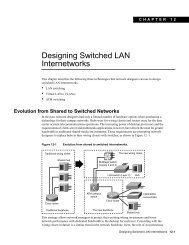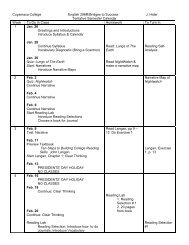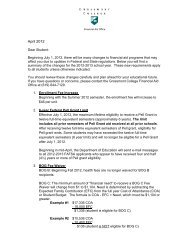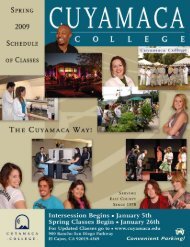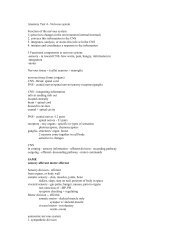SKILL PANEL REPORT California's Water Industry - Cuyamaca ...
SKILL PANEL REPORT California's Water Industry - Cuyamaca ...
SKILL PANEL REPORT California's Water Industry - Cuyamaca ...
You also want an ePaper? Increase the reach of your titles
YUMPU automatically turns print PDFs into web optimized ePapers that Google loves.
<strong>SKILL</strong> <strong>PANEL</strong> <strong>REPORT</strong> California’s <strong>Water</strong> <strong>Industry</strong>$69 BILLIONCALIFORNIA’S WATERAND WASTEWATERINFRASTRUCTURE NEEDSOVER THE NEXT 20 YEARS3
<strong>SKILL</strong> <strong>PANEL</strong> <strong>REPORT</strong> California’s <strong>Water</strong> <strong>Industry</strong>1EXECUTIVE SUMMARYThe oldest Baby Boomer turned 65 in 2011, and according to the Pew ResearchCenter, 10,000 Boomers will turn 65 every day through 2030. 1 Industries criticalto public health and safety -- think water, energy and healthcare -- must addressthis issue. According to the American <strong>Water</strong> Works Association, 30% of waterand wastewater system operators nationwide will reach retirement age by 2016.In California, 38 million people and the ninth largest economy in the worlddepend on the water industry for a safe and reliable water supply andwastewater sanitation. <strong>Water</strong> is the essential ingredient in everything, fromagriculture to manufacturing to the California lifestyle, and it Is not something wecan take for granted. Like the Boomers, much of California’s water andwastewater infrastructure is at retirement age, and the long term reliability of ourcurrent water resources is evaporating in the face of climate change andpopulation growth.Van Ton Quinlivan, Vice Chancellor of Workforce and Economic Developmentfor the California Community Colleges, asked <strong>Cuyamaca</strong> College to convenea panel of key people from water, education and workforce development todiscuss a collaborative approach to training the state’s next generation of waterindustry workers. Invitations were sent to people recognized by their peers forunderstanding the challenges facing California’s water utilities, job seekers andcommunity colleges; or, for already developing training solutions that can bemodeled statewide.Their recommendations are to develop water industry skill panels throughoutCalifornia and have each panel manage and market the career pathways in theirregion. It is a large task, but the panel believes these are the best strategies forcompeting against other industries for middle-skill workers and developing theskills the water industry needs. The panel wants to create a model for the regionsto use, and continue meeting until the model is completed. This report presentstheir findings: who the partners on a skill panel are, and what role they play.PanelistsPage 5How to Train theNext Generation of <strong>Water</strong><strong>Industry</strong> WorkersPage 6Regional Skill Panels:Partners & RolesK-12EDUCATIONPage 14CERTI-FICATIONPage 26WATERINDUSTRYPage 46Next StepsPage 50COMMUNITYCOLLEGESPage 21WORKFORCEINVESTMENTPage 45CAL STATEUNIVERSITYPage 494
<strong>SKILL</strong> <strong>PANEL</strong> <strong>REPORT</strong> California’s <strong>Water</strong> <strong>Industry</strong>2<strong>PANEL</strong>ISTSWATER & WASTEWATERCheryl DavisChair, BayworkSan Francisco Public Utilities Commissioncdavis@sfwater.orgTim WorleyExecutive DirectorCA/NV AWWAtworley@ca-nv-awwa.orgElizabeth AllenExecutive DirectorCalifornia <strong>Water</strong> Environment Associationeallen@cwea.orgGene PatricioUnit Manager, Apprentice andTechnical Training UnitMetropolitan <strong>Water</strong> District of So.Californiagpatricio@mwdh2o.comSimon WatsonManager, MaintenanceOrange County Sanitation Districtswatson@ocsd.comSue MosburgProgram SupervisorSweetwater Authoritysmosburg@sweetwater.orgChristine HawkinsHuman Resources ManagerSan Diego County <strong>Water</strong> Authoritychawkins@sdcwa.orgJennifer CasamassimaProgram ManagerCity of San Diegojcasamassima@sandiego.govKelli WilliamsonHuman Resources ManagerOtay <strong>Water</strong> Districtkwilliamson@otaywater.govKent TurnerReality Driven Consulting LLCkent.turner@r-dcllc.comEDUCATIONJennifer LewisDean, Continuing Education &Workforce Training<strong>Cuyamaca</strong> Collegejennifer.lewis@gcccd.eduCorine DoughtyDirector, Career Technical EducationSantiago Canyon Collegedoughty.corine@sccollege.eduDeborah MannDirector, Workforce & EconomicDevelopmentSolano Community Collegedeborah.mann@solano.eduDon JonesFaculty, <strong>Water</strong> Grant& <strong>Water</strong>/Wastewater Technology Program<strong>Cuyamaca</strong> Collegedonald.jones@gcccd.eduMollie SmithDirector, Occupational & Non-CreditProgramsPalomar Collegemsmith@palomar.eduDan ClawsonProject Manager, California <strong>Water</strong> InstituteInternational Center for <strong>Water</strong> Technology,Center for Irrigation TechnologyCSU Fresnodan.clawson@csufresno.eduJoe YoungFaculty, <strong>Water</strong> and Wastewater Technology<strong>Cuyamaca</strong> Collegejoseph.young@gcccd.eduDoug CoffinProject Lead the WaySantana High Schooldcoffin@guhsd.netZhenya LindstromCenter Director, Inland Empire/DesertCenters of Excellencezhenya.lindstrom@chaffey.eduCERTIFICATIONJon StrutzelOperator CertificationCalifornia Department of Public Healthalice.webber@cdph.ca.govWORKFORCEDEVELOPMENTDavid NarevskyLMI Business AnalystSan Diego Workforce Partnershipdavidnarevsky@workforce.orgTina NgoResearch ManagerSan Diego Workforce Partnershiptinango@workforce.orgRhonda Wooten-SavinoEmployment Development DepartmentState of Californiarwooten@edd.ca.govChris HarrisEmployment Development DepartmentState of Californiachristopher.harris@edd.ca.govDavid SilvaEmployment Development DepartmentState of Californiadavid.silva@edd.ca.govFACILITATORSarah HalsteadManagement ConsultantKatalyst DevelopmentStrategiess.halstead@katscandu.com5
<strong>SKILL</strong> <strong>PANEL</strong> <strong>REPORT</strong> California’s <strong>Water</strong> <strong>Industry</strong>3HOW TO TRAINCALIFORNIA’S NEXT GENERATIONOF WATER INDUSTRY WORKERSPanelFindingsIssues• Baby Boomer retirements• Training the next generation of workersRecommendations• Develop water industry skill panels• Develop water industry career pathwaysComments“We can’t herd a bunch of people intothe pipeline but not build the bridges towhat the industry needs. Where shouldwe invest?”“We want to target the smartest and beststudents for our industry”“We would do better collaboratively.”The Baby BoomersThe coming wave of Boomer retirements is often referred to as the SilverTsunami, an apt metaphor given the devastating impact on organizationalknowledge predicted when it hits. Boomers make up 51% of the country’smanagers and 49% of professionals, and when they retire, decades of jobspecific knowledge and organizational memory will go with them. 2Like other companies and industries, <strong>California's</strong> water and wastewater utilitieswill be hit hard. The Centers of Excellence, which provide labor market researchfor the California Community Colleges Economic and Workforce DevelopmentProgram, surveyed water and wastewater utilities in Southern California in 2011and found that 3,400 system operators, mechanics, electricians and instrumenttechnicians would be eligible for retirement by 2014. 3However, if that many workers are leaving, why can't community college studentsfind job openings at water and wastewater utilities? That was the question askedby panelists Corine Doughty, Deborah Mann and Mollie Smith, who manage thewater technology programs at Santiago Canyon Community College in OrangeCounty, Solano College in the Bay Area, and Palomar College in the San Diegoarea. This was the first of many let’s get to the point questions posed by thepanel over the one and a half day discussion.2011 Centersof ExcellenceReport7
<strong>SKILL</strong> <strong>PANEL</strong> <strong>REPORT</strong> California’s <strong>Water</strong> <strong>Industry</strong>Getting to the point is what happens when studies, data and traditional thinkingare all on the table, there are no sacred cows, each person is very good at whatthey do, and the purpose of the meeting is to come up with new ideas. The taskwas to develop strategies for training <strong>California's</strong> next generation of waterindustry workers -- in time to replace retiring Baby Boomers.As it turns out, eligible for retirement is not the same as retirement. Nationalstudies indicate that Boomers want to continue earning a paycheck and healthinsurance. Generation X employees aren't going anywhere either; 62% of 45 to60 year olds told the Conference Board in a 2012 survey that their financialassets have lost 20% or more of their value. 4The survey respondents pointed to the bursting of the housing bubble, the stockmarket crash, salary reductions and layoffs. The respondents probably convinceda few colleagues, too, because a 2012 survey by the Pew Research Centerfound that 38% of adults are “not too” or “not at all” confident that they will haveadequate income and assets for retirement. 5 It looks like the silver tsunami won'thit until interest rates on retirement funds rise or the Dow reaches 16,000.The Next GenerationWith the tsunami alert rescinded, <strong>California's</strong> water and wastewater utilities canfocus on an equally serious issue: there is a shortage of middle skill workers.These are workers who have more than a high school diploma but less than abachelor’s degree. The options in between include industry-based certificates,academic certificates and two year associate degrees attained at a communitycollege.Companies are already feeling the pain. When the Manufacturing Institutesurveyed 1,100 U.S. manufacturers in 2010, 95% of respondents reported ashortage of machinists, operators, technicians, distributors and craft workers, and86% reported a shortage of engineering technologists. 6Unfortunately, the shortage is expected to get worse. A 2010 study by theGeorgetown University Center on Education and the Workforce forecasts anational shortage of 4.7 million middle skill workers by 2018. 7 What this means isthat the competition will intensify between industries that need students and jobseekers interested in middle skill careers,<strong>California's</strong> water and wastewater utilities won't escape this trend. Mostoperations jobs in water are middle skill jobs, but so are a multitude of positionsin healthcare, energy, manufacturing, construction, transportation, hospitality,financial services, business and retail. Research by the Workforce Alliance showsthat 50% of jobs in California are middle skill jobs, but middle skill workers makeup just 38% of the state's workforce. 8Study:Georgetown UniversityCenter on Education andthe Workforce8
<strong>SKILL</strong> <strong>PANEL</strong> <strong>REPORT</strong> California’s <strong>Water</strong> <strong>Industry</strong>The State of Massachusetts launched the first skill panel in the country in 1981.Twenty five states were operating or implementing skill panels in 2010. Whilemanaging these partnerships is a considerable challenge, McKinsey’s 2012study of education to employment initiatives in the U.S. and eight other countriesshowed that skill panels are an effective recruiting strategy worth the effort. 944%of the employersnever interacted witheducation25%of them were findingthe talent they need31%of employers consideredinteracting with educationvery important69%of them reported no challenges inrecruiting the talent they needMcKinseyEducation to EmploymentStudyPanelist Don Jones, who helped develop <strong>Cuyamaca</strong> Colleges’s water technologyprogram, noted that, “<strong>Water</strong> utilities spend millions on long term capitalimprovement programs, CIPs, but very little on people improvement programs,PIPs.” The following examples show the additional incentives behindcollaborative skill panels and building people pipelines -- lower costs and higherproductivity.Georgia Power is one of 50utilities in a collaborative programwith four technical colleges forrecruiting and training electricalline workers. The collaborationreduced the number of initialcandidates for openings byalmost 90% and Georgia Powerreduced its own recruiting andtraining costs by 31%. The icing?Georgia Power’s employeeretention rate rose to 93%.(Harvard Business Review)UPS almost moved its hub out ofKentucky in 1996 because of ashortage of skilled workers.Instead, the State of Kentucky,Jefferson Community Collegeand UPS opened MetropolitanCollege. Students work part timewith full benefits on the UPS nightshift and attend college during theday. UPS and government spliteach student’s tuition costs andUPS pays for textbooks. Now,45% of UPS workers havepostsecondary degrees, andannual employee turnover isdown 80%.(Center for American Progress)When the wind energy industrydiscovered Oregon’s windy andsparsely populated ColumbiaRiver Gorge, Columbia GorgeCommunity College partneredwith Acciona Energy NorthAmerica, Black & Veatch andIntel to develop a regionalworkforce. One- and two-yearprograms now produce skilledworkers for wind energy,hydropower, automatedmanufacturing and engineeringtechnician positions, and Accionahas the service workers it needs.The placement rate for graduatesin wind energy is 80%.(Center for American Progress)10
<strong>SKILL</strong> <strong>PANEL</strong> <strong>REPORT</strong> California’s <strong>Water</strong> <strong>Industry</strong>CAREER PATHWAYSManagement / Leadership PositionBachelor’s / Master’s DegreeAssociate’s DegreeCareer AdvancementMultiple & Advanced CertificatesLevel 1 CertificateEntry Level PositionCommunity CollegeHigh School GraduationCreating, managing and marketing career pathways is what skill panels do.Career pathways introduce students and job seekers to the employers, careersand salaries in an industry, and show the path of courses, certificates, degreesand jobs to get there. There is also support along pathways, including mentors,counseling and financial aid.Upfront information and support along the way helps students, especiallydisadvantaged students, find their way to certification and employment. A case inpoint is Pooja Sankar, who was profiled in Money magazine. She grew up in theinterior of India among illiteracy and teenage marriage but had an educatedfather who wanted his daughter to have an education, too.When asked if their highschool career counsleorwas helpful, 58% ofpanelists said “No”.“Education is more than lectures, assignments, and exams. It's a means toenvision a different life from the one you're living,” states Sankar, who graduatedfrom the Indian Institute of Technology and developed the platform used byStanford, MIT and Princeton that allows students and teachers to have classdiscussions online. 10 Sankar says students need three things to succeed:11
<strong>SKILL</strong> <strong>PANEL</strong> <strong>REPORT</strong> California’s <strong>Water</strong> <strong>Industry</strong>1. A PathwayStudents need a plan for their education, not just access to classes.2. A Peer GroupThe ability to collaborate with peers “struggling with the same material at thesame time” prevents hopelessness and alienation.3. A Mentor“What was really most important in my education was that at key moments I wasable to envision the next step. Usually, I did it with the help of a mentor, or atleast someone who'd taken that next step before I had. The journey was personalbut guided.”Pooja Sankar:Rethinking the OnlineEducation RevolutionThere are numerous pathway programs across the U.S. that embody Sankar’srecommendations. One of these programs, the BioWork Certificate Program inNorth Carolina, is recognized as an example of best practices based on its highretention, completion and job placement rates. 11 What also makes it unique isthe level of interaction between students and workers, to each one’s benefit.BIOWORKBiogen Idec, GlaxoSmithKline andBayer collaborated with North CarolinaBiotechnology Center and NorthCarolina Community Colleges to createthe program.The 128 hour course trains workers forentry level jobs at 200 life sciencescompanies in North CarolinaCompanies help with coursedevelopment and provide state-ofthe-artequipment to the colleges forhands on trainingMultiple community colleges providethe courseComputer literacy, teamwork, timemanagement, and problem solvingare integrated into the curriculumThe course also provides a job marketoverview, job search tools andstrategies, resume preparation,and interviewing practiceCompanies send their own workers tothe program for specialized trainingCompany managers and engineersvisit classes, advise students on careeropportunities, and discuss technicaland organizational issuesAverage salary in North Carolina’slife sciences industry is higher thanthe state averageThe program has attracted other lifesciences companies to North Carolina12
<strong>SKILL</strong> <strong>PANEL</strong> <strong>REPORT</strong> California’s <strong>Water</strong> <strong>Industry</strong>Lastly, it is important to note that career pathways bring big financial benefits tostudents, just like skill panels bring big cost savings and productivity gains toemployers and community colleges – it is a win-win-win. The Aspen Institute, aneducational and policy studies organization, and Public/Private Ventures (nowissuelab.org) demonstrated this with longitudinal studies of participants in 12career pathways programs. They established each participant’s baseline situationand then tracked their post-training experience. Two years after training, theiroutlook was greatly improved. 12Baseline2 YearsAfter TrainingMEDIANINCOMEAspen Institute $8,580 $17,732INCOME P/P Ventures $10,486 $18,875YEAR ROUNDEMPLOYMENTAspen Institute 23% 66%EMPLOYMENT P/P Ventures 22% 61%HEALTHINSURANCEAspen Institute 50% 78%INSURANCE P/P Ventures 49% 73%These examples show a few important things. First, that business and education,and people from different industries can work well together. Second, theseexamples show that skill panels and career pathways really are proven strategiesfor producing a skilled workforce. Third, they show that helping students and jobseekers envision a career and better life is where it starts.Lastly, these examples show what people can accomplish at the regional level.High level collaboration is possible, perhaps because stakeholders share asense of community, The California Department of <strong>Water</strong> Resources and theCalifornia Community Colleges are among many organizations looking tomanage change one region at a time. Doing What Matters, the initiative launchedin 2013 by the California Community Colleges, encourages the colleges within aregion to collaborate and innovate to serve employers and job seekers in thebest possible way.Read moreThe panel believes this is how the water industry will attract the best andbrightest to join its ranks, and that regional collaboration among colleges isessential. The timing could not be better. What follows are the panel’srecommendations for each phase of a job seeker’s journey up a career pathway.13
<strong>SKILL</strong> <strong>PANEL</strong> <strong>REPORT</strong> California’s <strong>Water</strong> <strong>Industry</strong>4WHY K-12 EDUCATION MATTERSPanelFindingsIssues• Energy industry markets career opportunities to middle and high school students• Parents have a negative perception of water and wastewater careersRecommendations• Develop water industry marketing and community relations• Market career pathways to K-12 students, their parents and other job seekers• Market career pathways to middle and high school career counselors• Use water as a context to teach K-12 subjects -- math, science, social studies• Use STEM workshops and Edge GTS software to create curriculum• Model San Diego Unified School District: teachers and industry update and createcurriculum during summer• Use Perkins and SB1070 to develop courses that articulate from high school tocolleges to California State University• Bring college students back to talk to K-12 students• Bring K-12 students to Pathways Days at collegesComments“Our language, college vs. job, iswrong. Even our basic jobs have highstandards.”“Agencies are downsizing or usingtechnology and won’t replace everyretiree.”“If I get this degree in water, where elsecan I work?”“The industry is large. There arelots of jobs in water technology withtransferrable skills for water utilities.”“Every ship you see has a desal plant anda wastewater treatment plant on board.”“Breweries and industries withpretreatment systems want <strong>Cuyamaca</strong>students.”“We need to show parents that everydiscipline is available within the waterindustry.”“Silicon Valley is full of engineers, too.Market high paying jobs, not water, thenteach everything in a water context.”“This industry doesn’t share or explainitself. Needs to tell stories and engageMillennials.”“We’re most important to hard-luckstudents.”“We have pathways back to junior high.”14
<strong>SKILL</strong> <strong>PANEL</strong> <strong>REPORT</strong> California’s <strong>Water</strong> <strong>Industry</strong>CAREER PATHWAY<strong>Water</strong> DistributionSalaries$61,672 - $156,858Salaries$76,752 - $176,746Salaries$36,984 - $66,580Careers<strong>Water</strong> Systems Operator I<strong>Water</strong> Utility Worker IValve Maintenance Worker<strong>Water</strong> Distribution Tech. ISalaries$40-824 - $73,403Careers<strong>Water</strong> Systems Operator II<strong>Water</strong> Distribution Tech IIUtility Worker IIValve Maintenance WorkerSalaries$60,600 - $81,282Careers<strong>Water</strong> Quality Specialist<strong>Water</strong> Dist. Supervisor<strong>Water</strong> Systems Operator IIIAbove positions also require T2 - T4 certification<strong>Water</strong> DistributionCareersSuperintendentOperations Manager<strong>Water</strong> Systems Operator IIIBachelor’s Degree requiredCertification ExamComplete WWTR 101, 102, 130, 104, 106, 134, 265CareersDirector of OperationsAssociate’s Degree requiredComplete 3 additional courses fromWWTR 112, 270, 280, 282, 284, 290EHSM 100, 110, 210 / Complete generaleducation requirements / Complete aminimum of 60 unitsCertification ExamComplete WWTR 101, 102, 130Plus:1 yr D2 experience2 yrs totalPlus:1 yr D3 experience4 yrs totalPlus:2 yrs D4 experienceon a D4 or D5 system5 yrs totalGRADE D1certificateGRADE D2certificateGRADE D3certificateGRADE D4certificateGRADE D5certificateA valuable feature of career pathways is that an incumbent worker, transitioningadult, discharged veteran or student can jump onto the path at any point andknow what lies ahead and what they need to accomplish to get there. However, acareer pathway has to begin where high school ends because this is thetrailhead of all the other options.In fact, a student needs to know about a career pathway when they arecompleting college applications their junior year in high school; or earlier, whenthey are deciding whether to go to college, join the military or work full time; oryears before that, when they are becoming passionate about cities, theenvironment or science in middle school. This is where the competition formiddle skill workers begins.Should communitycolleges develop amid-career pathwayfor the water industry?77% of panelistssaid “Yes”.The energy industry understands this, and markets it’s career pathways to K-12students so they know where they are going after graduation. Over 80 energyutilities and national utility associations from across the country participate in the15
<strong>SKILL</strong> <strong>PANEL</strong> <strong>REPORT</strong> California’s <strong>Water</strong> <strong>Industry</strong>Center for Energy Workforce Development (CEWD) to collaboratively developsolutions to the industry’s approaching worker shortage.Their key initiative is the Get Into Energy website, which provides interactivecareer pathways and targeted career content for students, veterans, transitioningadults and women. The site is supported by public outreach and collaborationwith community colleges to produce internships, technical training and stackablecredentials.What does success look like? It looks like the photo and story in the OrangeCounty Register in October 2012 about 360 sixth graders conducting waterquality tests and learning about ecology on San Onofre Beach, courtesy of agrant from San Diego Gas & Electric to Orange County Coastkeeper.Read this CEWDwhite paper on recruitingThe water industry needs to compete with the energy industry for future workersbut does not appear to be trying. If it did, research suggests it would pique theinterest of Millennials. A 2009 survey of Millennials by the Center for AmericanProgress found that:Millennials are civic mindedThey strongly back investment in public schools and access tocommunity colleges67% believe they are more likely to be characterized by their concernfor the environment than other generations79% agree that it is each person’s individual responsibility to improvethe environment78% support clean energy alternatives 13“Our language,college vs. job, is wrong.Even our basic jobshave high standards.”i.e.MARKET OURCAREER PATHWAYSThe above comment came from panelist Cheryl Davis, who manages BayWork, apartnership of water utilities and community colleges in the Bay Area. Davis iscorrect. When McKinsey interviewed U.S. students for its 2012 study, 73% statedthat academic paths leading to white collar careers are valued more by societythan paths leading to blue collar careers.Preconceptions about careers in operations and the trades are a deterrent tostudents interested in the water industry and, unfortunately, the water industryhas done little to improve its image. It has not developed a brand, positioneditself as a green industry, promoted sustainability, or marketed its excellent16
<strong>SKILL</strong> <strong>PANEL</strong> <strong>REPORT</strong> California’s <strong>Water</strong> <strong>Industry</strong>salaries and benefits packages on a statewide scale. Combine that with the lackof transparency that characterizes most water agencies. Then add the fact that99% of what the water industry does is located underground, invisible to thepublic. And, while water officials sometimes laud the 400 mile CaliforniaAqueduct, they never speak proudly about the 2,500 miles of water and sewermains under Sacramento or the 17,000 miles of mains under Los Angeles.Marketing career pathways to middle school, high school, college and universitystudents is a targeted and efficient way to overcome these image deficits. Reallygood pathway designs, that match courses with certificates, certificates with jobsand jobs with salaries, help students envision a bright future. The draft design onpage 15 is a good example.How the CanadianApprenticeship ForumRecruits Students“If I get thisdegree in water,where else canI work?”i.e.BE AN INDUSTRY<strong>Water</strong> and wastewater utilities are independent organizations formed decadesago by local ballot measure. In the San Diego region, there are 24 water andwastewater utilities and one energy utility. The energy utility is a recognizedbrand name, and the water utilities are not. The situation is the same in the LosAngeles region and the Bay Area.<strong>Water</strong> and wastewater utilities can even the workforce development playing fieldby developing water industry clusters. The most widely known industry cluster isSilicon Valley. While the public does not recognize most of the brand names inSilicon Valley, they know that the region, and the companies in it, are important.INDUSTRY CLUSTERENGINEERINGCONSULTANTSWATER &WASTEWATERAGENCIESCITIESCOUNTYGENERALCONTRACTORSMANU-FACTURERSSUPPLYCHAINLANDSCAPE& IRRIGATIONINDUSTRY17
<strong>SKILL</strong> <strong>PANEL</strong> <strong>REPORT</strong> California’s <strong>Water</strong> <strong>Industry</strong>In San Diego County, the water industry cluster includes the desalinationindustry: 35 manufacturers with 2,200 jobs and $200 million in annual revenue.San Diego is also home to Hunter Industries, a global manufacturer of irrigationproducts. In any region in California, the water industry cluster includesconstruction and engineering firms, the landscaping industry, cities and countiesand manufacturers. Panelist Kent Turner reminded the group that “Every shipyou see has a desal plant and a wastewater treatment plant on board.” DonJones added that, “Breweries and industries with pretreatment want <strong>Cuyamaca</strong>students.” This is networking at the organizational level.“Don’t market water.Market water’s highpaying jobs. Then teacheverything in a watercontext.”i.e.IMPRESS PARENTS<strong>Industry</strong> Cluster FAQsOregon Business PlanThe above comment was made by panelist Doug Coffin, a Career and TechnicalEducation instructor at Santana High School in the San Diego area. He createdthe Engineering, Energy and Utilities Academy at Santana, develops pathways tocareers with utilties for sophomores, and pushes the school’s top seniors towardsengineering careers. Some of those seniors are now studying at Stanford, MITand Princeton.Parents will be less concerned about their child choosing a future that includeswastewater when they see the career pathways, salaries and the companies inthe industry cluster. To win them over completely, throw in the followingarguments:1. Tuition ReimbursementMany water utilities in California provide workers with tuition reimbursement atthe California State University level. A recommended education strategy is tostudy water technology for one or two semesters at a community college, earn agrade 1-2 certificate in water distribution, water treatment or wastewatercollection, and search for an entry level, Utility Worker I position at a utility. Oncehired, utilize tuition reimbursement to pursue additional certificates and a degree.2. Hourly Wage of a Utility Worker IThe hourly wage for a <strong>Water</strong> Utility Worker I is $24.85 to $30.20 at Contra Costa<strong>Water</strong> District in the Bay Area; $23.23 to $29.03 at Otay <strong>Water</strong> District in SanDiego; and employees receive health insurance, paid vacation and retirement, aswell. 1418
<strong>SKILL</strong> <strong>PANEL</strong> <strong>REPORT</strong> California’s <strong>Water</strong> <strong>Industry</strong>3. <strong>Industry</strong> Certificate vs. Bachelor’s DegreeThis 2009 chart from the Hudson Institute shows the median salary three to fiveyears after college for each type of credential. 15Bachelors Degree$39,420Associates Degree$31,468<strong>Industry</strong> Certificate$37,044No Credential $29,112The water industry has the goods to compete for the best and brightest studentsand job seekers in California. If this information appeared on a website that waspromoted by a blog, social media and industry involvement in schools, includingemployers talking to students and hosting field trips, the secret might just get out.19
<strong>SKILL</strong> <strong>PANEL</strong> <strong>REPORT</strong> California’s <strong>Water</strong> <strong>Industry</strong>TRAINING& CERTIFICATIONARE THE TICKETTO A GREATCAREER20
<strong>SKILL</strong> <strong>PANEL</strong> <strong>REPORT</strong> California’s <strong>Water</strong> <strong>Industry</strong>5CAN COMMUNITY COLLEGES CLOSETHE <strong>SKILL</strong> GAPS IN THE WATER INDUSTRY?PanelFindingsIssues• Closing water industry skill gaps• Mechanical, electrical and construction trade skills• Grade 1-2 operators need to replace retiring grade 3-5 operators• Foundation and workplace skills• Math• Communications• Project management• <strong>Industry</strong> awareness• Networking• Life long learning• Initiative• Do agencies want entry level workers they can train themselves, or journeyman level?• Hands-on facilities require industry supportRecommendations• Develop hands on technical training opportunities• Perform cost benefit analysis of immersion, facility based, blended learning models• Stakeholders who benefit should provide funding• Design curriculum for Millennials that develops foundation skills• Partner with industry associations to provide mid-career pathwaysComments“There’s not a shortage of operators.The shortage is hands-on electricians,machinists and carpenters.”“We let electricians walk off ships in SanDiego and don’t hire them because theydon’t have water industry experience.”“50% of my hands on people come fromthe military.”“We hire Operators in Training and theybetter have their T1. The communitycolleges don’t cater to hands on ability --electrical shops, pump disassembly.”“There could be a centralizedapprenticeship program, but could theagencies come to an agreement?”“Agencies vary. Some hire entry level anddevelop them; some hire journey level.”“The state has lots of T1’s and T2’s, butit’s the T3, 4 and 5 operators who areretiring.”“Should we grow our own, or take a riskon an outside entity?”“MWD has scaled back education.”21
<strong>SKILL</strong> <strong>PANEL</strong> <strong>REPORT</strong> California’s <strong>Water</strong> <strong>Industry</strong>When asked to identify the skill gaps in water agencies, from both the employerand customer perspectives, the panel did not want to talk about climate change,new regulations or new technologies. In fact, that discussion was a non-starter,because the panel quickly identified and agreed upon two skill gaps.“How do we motivateGeneration Y? They havea different mindset.”i.e.ATTITUDEAND BASIC <strong>SKILL</strong>SPanelist Joe Young made that comment. He is a retired engineer and full timeinstructor in the <strong>Water</strong> and Wastewater Technology Program at <strong>Cuyamaca</strong>College. Attitude, reasoning, judgement and communications skills – listening,speaking, reading and writing – are called foundation skills because they give anindividual the ability to learn other skills. The stronger the foundation, the higherthe individual can build. However, when a person brings weak foundation skills tothe workplace, it impacts other workers, processes and outcomes. According topanelists, this is what is happening with younger workers at water agencies.This is a common complaint across industries. When the Society for HumanResources Management surveyed human resources managers in 2012, 52%said older workers exhibit a stronger work ethic, and 51% said they havestronger language, writing and spelling skills. A 2011 report from America’s Edgerevealed that 70% of students in California’s community colleges need remedialmath and English instruction before enrolling in their declared major. The reportalso found that only 33% of graduates in the high school class of 2007 met theeligibility requirements for admission to a California State University.What these reports show is that students arrive at California’s communitycolleges with a skill gap and take the gap with them into the workplace. Thequestion is whether the California Community Colleges can improve studentfoundation skills in addition to teaching students job specific skills. Again, thetiming could not be better. Because one of the four goals of the CaliforniaCommunity Colleges’ Doing What Matters initiiative is retooling courses,curriculum and instructor training to meet the needs of employers. <strong>Water</strong> industryinstructors, most of whom are adjunct faculty, need the tools to engage studentswho grew up with video games, the internet, smart phones and social media.The traditional lecture is the least effective teaching approach for this generationof students. The approach used by college and university faculty throughout thecountry is to change what a class is doing every 10-15 minutes, use multimediacontent and engage students in in-class group activities and project-basedlearning. This may be one reason why the apprenticeship programs offered bythe energy industry have been successful and effective -- they cut classroomtime in half and engage students in hands-on, technical training.The MillennialGeneration&The LectureDanielle Hart, MD22
<strong>SKILL</strong> <strong>PANEL</strong> <strong>REPORT</strong> California’s <strong>Water</strong> <strong>Industry</strong>“There’s nota shortage of operators.The shortage is hands-onelectricians, machinistsand carpenters.”i.e.TECHNICAL <strong>SKILL</strong>SPanelist Simon Watson said this. He manages maintenance for the OrangeCounty Sanitation District. It’s not an easy job. The district treats 207 milliongallons of wastewater each day at two treatment plants, purifies 70 milliongallons and injects it into the district’s world renowned GroundwaterReplenishment System, and recycles enough energy from the treatment processto operate two thirds of the facility. The district also operates and maintains 15off-site pump stations and 587 miles of pipe.Who will train those electricians, machinists and carpenters is an open question.The survey of Southern California water agencies conducted by the Centers ofExcellence in 2011 also looked at 12 of the community colleges training theirworkers. It found that, while all 12 colleges offered training for certification as awater distribution or water treatment operator, few trained students for the PlantMaintenance Technologist, Electrical/Instrumentation Technologist or MechanicalTechnologist certificates from the California <strong>Water</strong> Environment Association. 16This is the training that produces the electricians and machinists that Watson hasdifficulty hiring.2011 COE Survey23
<strong>SKILL</strong> <strong>PANEL</strong> <strong>REPORT</strong> California’s <strong>Water</strong> <strong>Industry</strong>The panel’s recommendation is to explore opportunities for hands-on technicaltraining programs. Panelists from community colleges see this as a bridge toemployment for students, but acknowledge that colleges do not have funding forthe facilities and equipment needed for hands-on training. “This is a hugeproblem and I would like the report to reflect the lack of apprenticeships,” saidpanelist Corine Doughty. Panelists from the water industry pointed out that waterand wastewater agencies vary; some prefer to hire entry level workers and trainthem in-house while others prefer to hire journey level workers.How do we learn best?73% of panelists said“Show Me”One model is offered by <strong>Cuyamaca</strong> and Palomar Colleges: a six year oldinternship program with the 24 water and wastewater agencies in the San Diegoregion. The 33 week program includes orientation and four 8-week modules --hands-on time in system operations, system maintenance, water treatment andwastewater treatment. Participants are selected through an interview processand must maintain at least a “C” average in the accompanying classwork. So far,42 of the 57 graduates have been hired.Metropolitan <strong>Water</strong> District of Southern California, Los Angeles Department of<strong>Water</strong> and Power and the San Francisco Public Utilities Commission haveapprenticeships, too, because of their large size and large unions. Panelist GenePatricio manages the Apprentice and Technical Training Unit at Metropolitan<strong>Water</strong> District of Southern California. While Metropolitan prefers to develop itsown workers in its own facilities, Patricio acknowledged that finding qualifiedtrainers is difficult and that the district is scaling back the program. “There couldbe a centralized apprenticeship program,” he said, and then asked, “Can theagencies come to an agreement?”The question is whether skill panels make water industry apprenticeshippossible, and the answer appears to be yes. By bringing employers, educationand workforce investment boards together at the regional level, skill panelsprovide the collaboration, management team and access to funding needed.Regional skill panels also give small utilities access to training on a larger scale.The panel’s recommendation is to follow up with a cost benefit analysis ofimmersion, facility based and blended learning models.Promising, too, is that the California Community Colleges support apprenticeshipprograms throughout the state: approximately 25,000 apprentices are enrolled inover 160 programs at 39 campuses. 17 Each apprenticeship program is apartnership between an employer and the California Community Colleges or theCalifornia Department of Education, and apprentices learn on the job during theday and attend college in the evening for Related and Supplemental Instruction(RSI) selected by the employer. Allowing regional skill panels to utilize thissuccessful model and partner with the California Community Colleges to fundapprenticeship programs would be an exciting next step. Perhaps the DoingWhat Matters initiative is the vehicle to make this happen.24
<strong>SKILL</strong> <strong>PANEL</strong> <strong>REPORT</strong> California’s <strong>Water</strong> <strong>Industry</strong>INTEGRATEDWATER MANAGEMENTMULTIPLE BENEFITSMULTIPLE <strong>SKILL</strong>SMULTIPLE JOBS25
<strong>SKILL</strong> <strong>PANEL</strong> <strong>REPORT</strong> California’s <strong>Water</strong> <strong>Industry</strong>6IS CERTIFICATION ALIGNEDWITH THE WATER INDUSTRY?PanelFindingsIssues• Job seekers and instructors find certification structure confusing• Certification, colleges and industry not working collaborativelyRecommendations• No micro credentials• Help students combine multiple industry recorgnzied certificates• Mid-career pathways• Coordinate AWWA, CWEA, college and utility trainingComments“We already have a plethora ofcredentials.”“I need a roadmap of certifications.”“Whether to get certified in water orwastewater is the most common email Iget.”“What should we say to people? Whichcertificate? Match certificates to jobs.”“We don’t ask for a certificate. We ask forcertification.”“Bay area employers want the collegecertificate.”“Community colleges are for studentswanting to get into the industry andassociations are for continuingeducation.”“Let’s be honest. We all compete fortrainees.”“AWWA is recognized nationally andinternationally.”26
<strong>SKILL</strong> <strong>PANEL</strong> <strong>REPORT</strong> California’s <strong>Water</strong> <strong>Industry</strong>“We already have aplethora of credentials.”i.e.NO MICRO-CREDENTIALSWhile the panel recognizes the educational goals of micro-credentials — to helpjob seekers earn and stack credentials within one year — they see more harmthan good in adding new credentials to a certification system that is alreadyconfusing to students, instructors and employees alike. It is important to note,too, that current water industry certificates meet micro-credential goals. Therecommended preparation for the Grade 2 Certification Exam in waterdistribution or water treatment is two or three 8-week courses. Each course is 3units and total time in class is 144 hours. <strong>Water</strong> industry certificates arestackable, too.“Whether to getcertified in water orwastewater is the mostcommon email I get.”i.e.ALIGNMENT WITHTHE INDUSTRYThe industry is more than water and wastewater. In 2002, the Californialegislature passed the Integrated Regional <strong>Water</strong> Management Act to encouragewater utilities to collaboratively manage water quality and reliability. The sameyear, Californians passed Proposition 50, which provided $500,000,000 to fundcompetitive grants for integrated water projects. This year, integrated regionalwater management appears to be gaining traction:The San Diego City Council approved an indirect potable reuse projectto provide up to 40% of the city’s water supply. The key to approval?The project reduces the need for upgrades to the city’s wastewatertreatment plant, saving about $1,000 per acre foot of water. 18In its 2013 Report Card on American Infrastructure, the AmericanSociety of Civil Engineers recognizes cities that are using greeninfrastructure solutions to reduce combined sewer overflows. 19The Los Angeles Bureau of Sanitation turned a nine acre, underutilizedmaintenance yard into a stormwater wetland park, creating recreationalgreenscape in a disadvantaged community. 20These three examples show how utilities are now managing water, wastewater,stormwater and land use in a single project. In an interview with Brown &Caldwell, the Los Angeles Bureau of Sanitation’s assistant director, AdelHagekhalil, describes how far integration goes:27
<strong>SKILL</strong> <strong>PANEL</strong> <strong>REPORT</strong> California’s <strong>Water</strong> <strong>Industry</strong>We are maximizing the capture and reuse of our resources. Theseinclude maximizing water reuse, harvesting rainwater, constructinggreen projects, reusing biosolids, converting biogas to energy, andintegrating solar energy into our facilities. 21Clearly, integrated regional water management involves skills beyond watertreatment and distribution and wastewater collection and treatment. <strong>Water</strong>conservation specialists work outside their certification, too, advisinghomeowners how to manage stormwater and prevent urban runoff. Why?Because rainwater harvesting is now recognized as a water efficienctlandscaping best practice, and landscaping strategies – green infrastructure –are now regarded as a stormwater management best practice.The California Stormwater Quality Association states that it is developing a lowimpact development certificate, but does not provide a timeframe, and theAmerican <strong>Water</strong> Works Association certificate for water use efficiencypractitioners does not address stormwater. An updated, integrated certificatewould help water efficiency experts gain entrance into stormwater managementpositions and projects.The Pacific Northwest Center of Excellence for Clean Energy provides acompelling model for updating the range of knowledge and requirements forwater industry certificates. The Center’s Energy <strong>Industry</strong> Skill Standards Projectis identifying critical work functions, key activities, performance indicators and theknowledge, skills, and abilities an individual needs to succeed in certain energyrelatedoccupations. The goal of the project is to update and develop newcommunity college curriculum.Who is doing the work? Focus groups of front line employees with hands onexperience in each occupation. They are selected from different utilities so thatprocedures can be compared, and they work for two days with a facilitatorexperienced in developing skill standards.“What should wesay to people? Whichcertificate? Matchcertificates to jobs.”i.e.SIMPLIFICATIONThe comment above was from panelist Rhonda Wooten-Savino, one of threepanelists from the State of California’s Economic Development Department, whoworks with veterans transitioning into civilian employment. They need to provideaccurate information and advice. Pages 29-43 show each water industrycertificate and how to prepare for it. The analysis revealed the complexity of thevarious certification programs and how curriculum varies from college to college.Adel HagekhalilPp 29-43Certificates & Courses29. <strong>Water</strong> Treatment30. <strong>Water</strong> Distribution31. <strong>Water</strong> Quality LaboratoryAnalyst32. Backflow Prevention33. Cross Connection Specialist34. <strong>Water</strong> Use EfficiencyPractitioner35. Irrigation Auditor/Manager36. Collection SystemMaintenance37. Environmental ComplianceInspector38. Wastewater Treatment39. industrial Treatment40. Plant Maintenance /Electrical / Instrumentation41. Plant Maintenance /Mechanical42. Laboratory Analyst(Wastewater)43. Biosolids Land ApplicationManagement28
<strong>SKILL</strong> <strong>PANEL</strong> <strong>REPORT</strong> California’s <strong>Water</strong> <strong>Industry</strong>WATER TREATMENTCertificates<strong>Water</strong> Treatment Operator / California Department of Public Health (CDPH)<strong>Water</strong> Treatment Operator / American <strong>Water</strong> Works Association (AWWA)<strong>Water</strong> Treatment Associate / American <strong>Water</strong> Works Association (AWWA)Qualifications to Take Certification ExamAgencyDegrees& CertificationTreatmentPlant ExperienceCoursesT1 CDPH Diploma / GED none noneAWWA Diploma / GED 6 mos 3 unitsT2 CDPH Diploma / GED none 3 unitsAWWA Diploma / GED 2 yrs / 1 yr at T1 in T1 plant 6 unitsT3 CDPH Diploma / GED 2 yrs / 1 yr at T2 in T2 plant 6 unitsAWWA Diploma / GED 4 yrs / 1 yr at T2 in T2 plant 9 unitsT4 CDPH Diploma / GED 4 yrs / 1 yr at T3 in T3 plant 9 unitsAWWA Diploma / GED 5 yrs / 2 yrs at T3 in T3 plant 12 unitsT5 CDPH Diploma / GED 5 yrs / 2 yrs at T4 in T4 plant 12 unitsNote:AWWA Associate Certificaterequires degree and courseworkonly.Core CoursesT1-3*T3-5*Most Common Courses<strong>Water</strong> and Wastewater MathematicsApplied HydraulicsInstrumentation and Controls<strong>Water</strong> Treatment I / Basic<strong>Water</strong> Treatment II / AdvancedLess Common CoursesIntroduction to <strong>Water</strong> and WastewaterLaboratory Analysis / Chemistry* Most of the schools offer classes to prepare students for grade 1-3 certificates, and advancedclasses to prepare them for grade 4-5 certificates. From college to college, however, a fewcourses prepared students for grade 1-2 certificates only.29
<strong>SKILL</strong> <strong>PANEL</strong> <strong>REPORT</strong> California’s <strong>Water</strong> <strong>Industry</strong>WATER DISTRIBUTIONCertificates<strong>Water</strong> Distribution Operator / California Department of Public Health<strong>Water</strong> Distribution Operator / American <strong>Water</strong> Works Association<strong>Water</strong> Distribution Associate / American <strong>Water</strong> Works AssociationQualifications to Take Certification ExamAgencyDegrees& CertificationDistributionSystem ExperienceCoursesD1 CDPH Diploma / GED none noneAWWA Diploma / GED 6 mos 3 unitsD2 CDPH Diploma / GED none 3 unitsAWWA Diploma / GED 2 yrs / 1 yr at D1 on D1 system 6 unitsD3 CDPH Diploma / GED 2 yrs / 1 yr at D2 on D2 system 6 unitsAWWA Diploma / GED 4 yrs / 1 yr at D2 on D2 system 9 unitsD4 CDPH Diploma / GED 4 yrs / 1 yr at D3 on D3 system 9 unitsAWWA Diploma / GED 5 yrs / 2 yrs at D3 on D3 system 12 unitsD5 CDPH Diploma / GED 5 yrs / 2 yrs at D4 on D4 system 12 unitsNote:AWWA Associate Certificaterequires degree and courseworkonly.Core CoursesD1-3 Most Common Courses<strong>Water</strong> and Wastewater MathematicsHydraulicsMechanical and Electrical Systems<strong>Water</strong> Distribution Systems I / BasicLess Common CoursesIntroduction to <strong>Water</strong> and WastewaterBackflow Prevention TestingCross Connection SpecialistD3-5 <strong>Water</strong> Distribution II / Advanced30
<strong>SKILL</strong> <strong>PANEL</strong> <strong>REPORT</strong> California’s <strong>Water</strong> <strong>Industry</strong>WATER QUALITY LABORATORY ANALYSTCertificates<strong>Water</strong> Quality Laboratory Analyst / American <strong>Water</strong> Works AssociationQualifications to Take Certification ExamNote the various ways to qualify.AgencyDegrees& Certification<strong>Water</strong> QualityLaboratory ExperienceGr1 AWWA Diploma / GED 1 yrGr2 AWWA Diploma / GED 4 yrsAA / AS DegreeBA / BS Degree2 yrs1 yrGr3 AWWA Diploma / GED 7 yrsAA / AS DegreeBA / BS Degree5 yrs3 yrsGr4 AWWA Diploma / GED 10 yrsAA / AS DegreeBA / BS DegreeAdvanced Degree8 yrs6 yrs4 yrsCore CoursesGr1-2Most Common CoursesLab Analysis for <strong>Water</strong> and Wastewater<strong>Water</strong> Treatment I / BasicLess Common Courses<strong>Water</strong> Treatment II / Advanced31
<strong>SKILL</strong> <strong>PANEL</strong> <strong>REPORT</strong> California’s <strong>Water</strong> <strong>Industry</strong>BACKFLOW PREVENTIONCertificatesBackflow Prevention Assembly Tester / American <strong>Water</strong> Works AssociationBackflow Prevention Assembly Tester / American Backflow Prevention AssociationBackflow Prevention Specialist / American Backflow Prevention AssociationQualifications to Take Certification ExamNote the various ways to qualify.AgencyDegrees& CertificationBackflowPrevention ExperienceCoursesTester AWWA Diploma / GED none 40 hrsDiploma / GED 2 yrs noneTester ABPA Diploma / GED none 40 hrsDiploma / GED 2 yrs noneSpecialist ABPA Backflow Tester Certification none 3 unitsBackflow Tester Certification 2 yrs noneNone 5 yrs of specialist experience noneCore CoursesGr1-2Most Common CoursesBackflow Prevention Testing32
<strong>SKILL</strong> <strong>PANEL</strong> <strong>REPORT</strong> California’s <strong>Water</strong> <strong>Industry</strong>CROSS CONNECTION SPECIALISTCertificatesCross Connection Specialist / American <strong>Water</strong> Works AssociationQualifications to Take Certification ExamNote the various ways to qualify.AgencyDegrees& CertificationCross ConnectionSpecialist ExperiencesCoursesAWWADiploma / GEDNone40 hrs& Backflow PreventionAssembly Tester Certificate* 2 yrs noneCore CoursesMost Common CourseCross Connection SpecialistLess Common CoursesMathematics for <strong>Water</strong> and WastewaterApplied Hydraulics<strong>Water</strong> Distribution I33
<strong>SKILL</strong> <strong>PANEL</strong> <strong>REPORT</strong> California’s <strong>Water</strong> <strong>Industry</strong>WATER USE EFFICIENCY PRACTITIONERCertificates<strong>Water</strong> Use Efficiency Practitioner / American <strong>Water</strong> Works AssociationQualifications to Take Certification ExamAgencyDegrees& Certification<strong>Water</strong> UseEfficiency ExperienceCoursesCA* AWWA Diploma / GED none 0-3 unitsGr1 AWWA Diploma / GED 6 mosGr2 AWWA Grade 1 Certificate 2 yrs of experience in:- water/energy public education- landscaping- water conservation at a water utility- a Field Services Worker II position* CA = Certificate of Achievement. Must be enrolled in a waterworks course and in good standing.Core CoursesGr1Gr2Most Common Course<strong>Water</strong> Use Efficiency PractitionerLess Common Courses<strong>Cuyamaca</strong> College offers a 35-41 unitcertificate that provides extensive trainingin water efficient landscaping.Less Common<strong>Water</strong> Conservation34
<strong>SKILL</strong> <strong>PANEL</strong> <strong>REPORT</strong> California’s <strong>Water</strong> <strong>Industry</strong>IRRIGATION AUDITOR / MANAGERCertificateCertified Landscape Irrigation Auditor / Irrigation AssociationCertified Landscape <strong>Water</strong> Manager / Irrigation AssociationCertified <strong>Water</strong> Manager / California Landscape Contractors AssociationQualifications to Take Certification ExamAgencyDegrees& CertificationIrrigation ExperienceAuditor IA None 1 yrManager IA Irrigation Auditor Certificate 3 yrsManager CLCA None NoneCore CoursesMost Common Course<strong>Water</strong> Use Efficiency PractitionerLess Common Courses<strong>Cuyamaca</strong> College offers a 35-41 unitcertificate that provides extensive trainingin water efficient landscaping.35
<strong>SKILL</strong> <strong>PANEL</strong> <strong>REPORT</strong> California’s <strong>Water</strong> <strong>Industry</strong>COLLECTION SYSTEM MAINTENANCECertificateCollection System Maintenance / California <strong>Water</strong> Environment AssociationQualifications to Take Certification ExamNote the various ways to qualify.AgencyDegrees& CertificationCollection SystemMaint. ExperienceGr1 CWEA None noneGr2 CWEA None 4 yrsGrade 1 Collection Maint. Certificate for 1 yearAA / AS DegreeBA / BS Degree2 yrs2 yrs1 yrGr3 CWEA None 6 yrsGrade 2 Collection Maint. Certificate for 2yearsAA / AS DegreeBA / BS Degree4 yrs4 yrs3 yrsGr4 CWEA None 8 yrs / 1 yr as supervisorGrade 3 Collection Maint. Certificate for 2yearsAA / AS DegreeBA / BS Degree6 yrs / 1 yr as supervisor6 yrs / 1 yr as supervisor5 yrs / 1 yr as supervisorCore CoursesGr1-2Gr3-4Most Common Courses<strong>Water</strong> and Wastewater MathematicsMechanical and Electrical MaintenanceInstrumentation and ControlsWastewater Collection IWastewater Collection II36
<strong>SKILL</strong> <strong>PANEL</strong> <strong>REPORT</strong> California’s <strong>Water</strong> <strong>Industry</strong>WASTEWATER TREATMENTCertificateWastewater Treatment Plant Operator / State <strong>Water</strong> Resources Control BoardAgencyDegrees& CertificationWastewaterTreatment ExperienceCoursesGr1 SWRCB None none 6 unitsGr2 SWRCB Diploma / GED 2 yrs 6 unitsDiploma / GEDGrade 1 Certificate1.5 yrs at T1 6 unitsGr3 SWRCB Diploma / GED 4 yrs 6 unitsDiploma / GEDGrade 2 Certificate3 yrs at T2 6 unitsAA / AS Degree (or units) 2 yrs 60 unitsGr4 SWRCB Diploma / GED 6 yrs 12 unitsDiploma / GEDGrade 3 Certificate4 yrs at T3 12 unitsAA / AS Degree (or units) 4 yrs 60 unitsBA / BS Degree2 yrsGr5 SWRCB Diploma / GED !0 yrs 18 unitsDiploma / GEDGrade 4 Certificate6 yrs at T4 18 unitsAA / AS Degree (or units) 6 yrs 60 unitsBA / BS DegreeCivil or chemical engineer license5 yrs4 yrsCore CoursesGr1-3Gr4-5More Common Courses<strong>Water</strong> and Wastewater MathematicsMechanical and Electrical SystemsInstrumentationWastewater Treatment I / BasicWastewater Treatment II / AdvancedLess Common CoursesIntroduction to <strong>Water</strong> and WastewaterWastewater Recycling38
<strong>SKILL</strong> <strong>PANEL</strong> <strong>REPORT</strong> California’s <strong>Water</strong> <strong>Industry</strong>INDUSTRIAL WASTE TREATMENTCertificateIndustrial Waste Treatment Plant Operator / California <strong>Water</strong> Environment AssociationQualifications to Take Certification ExamNote the various ways to qualify.AgencyDegrees& CertificationIndustrial TreatmentExperienceGr1 CWEA None noneGr2 CWEA None 4 yrsGrade 1 Indus. Trmt. Operator Certificate for1 yrAA / AS DegreeBA / BS Degree2 yrs2 yrs1 yrGr3 CWEA None 6 yrsGrade 2 Indus. Trmt. Operator Certificate for2 yrsAA / AS DegreeBA / BS Degree4 yrs4 yrs3 yrsGr4CWEA None 8 yrs / 1 yr assupervisorGrade 3 Indus. Trmt. Operator Certificate for1 yrAA / AS DegreeBA / BS Degree6 yrs / 1 yr assupervisor6 yrs / 1 yr assupervisor5 yrs / 1 yr assupervisorCore CoursesCSU Sacramento offers course.39
<strong>SKILL</strong> <strong>PANEL</strong> <strong>REPORT</strong> California’s <strong>Water</strong> <strong>Industry</strong>PLANT MAINTENANCE: ELECTRICAL / INSTRUMENTATIONCertificatePlant Maintenance Technologist, Grade 1 / California <strong>Water</strong> Environment AssociationElectrical / Instrumentation Technologist, Grades 2-4 / California <strong>Water</strong> Environment AssociationQualifications to Take Certification ExamNote the various ways to qualify.AgencyDegrees& CertificationElectrical /InstrumentationExperienceGr1 CWEA None noneGr2 CWEA None 4 yrsGrade 1 Plant Maintenance Certificate for 1yrAA / AS DegreeBA / BS Degree2 yrs2 yrs1 yrGr3 CWEA None 6 yrsGrade 2 Electrical / Instrumentation Cert. for2 yrsAA / AS DegreeBA / BS Degree4 yrs4 yrs3 yrsGr4CWEA None 8 yrs / 1 yr assupervisorGrade 3 Electrical / Instrumentation Cert. for2 yrsAA / AS DegreeBA / BS Degree6 yrs / 1 yr assupervisor6 yrs / 1 yr assupervisor5 yrs / 1 yr assupervisorCore CoursesGr2Most Common CoursesMechanical and Electrical SystemsIntro. to Electrical and InstrumentationProcessesElectrical Wiring and Controls for OperatorsLess CommonWastewater Treatment PlantOperations I40
<strong>SKILL</strong> <strong>PANEL</strong> <strong>REPORT</strong> California’s <strong>Water</strong> <strong>Industry</strong>PLANT MAINTENANCE: MECHANICALCertificatePlant Maintenance Technologist, Grade 1 / California <strong>Water</strong> Environment AssociationMechanical Technologist, Grades 2-4 / California <strong>Water</strong> Environment AssociationQualifications to Take Certification ExamNote the various ways to qualify.AgencyDegrees& CertificationMechanicalExperienceGr1 CWEA None noneGr2 CWEA None 4 yrsGrade 1 Plant Maintenance Certificate for 1yrAA / AS DegreeBA / BS Degree2 yrs2 yrs1 yrGr3 CWEA None 6 yrsGrade 2 Mechanical Certificate for 2 yrsAA / AS DegreeBA / BS Degree4 yrs4 yrs3 yrsGr4CWEA None 8 yrs / 1 yr assupervisorGrade 3 Mechanical Certificate for 2 yrsAA / AS DegreeBA / BS Degree6 yrs / 1 yr assupervisor6 yrs / 1 yr assupervisor5 yrs / 1 yr assupervisorCore CoursesGr1-2Most Common CoursesMechanical and Electrical SystemsMechanical MaintenanceMotors and Pumps Operations andMaint.Less CommonWastewater Treatment PlantOperations I41
<strong>SKILL</strong> <strong>PANEL</strong> <strong>REPORT</strong> California’s <strong>Water</strong> <strong>Industry</strong>LABORATORY ANALYST (WASTEWATER)CertificateLaboratory Analyst Grades 1-4 / California <strong>Water</strong> Environment AssociationQualifications to Take Certification ExamNote the various ways to qualify.AgencyDegrees& CertificationMechanicalExperienceGr1 CWEA None noneGr2 CWEA None 4 yrsGrade 1 Lab Analyst Certificate for 1 yrAA / AS DegreeBA / BS Degree2 yrs2 yrs1 yrGr3 CWEA None 6 yrsGrade 2 Lab Analyst Certificate for 2 yrsAA / AS DegreeBA / BS Degree4 yrs4 yrs3 yrsGr4CWEA None 8 yrs / 1 yr assupervisorGrade 3 Lab Analyst Certificate for 2 yrsAA / AS DegreeBA / BS Degree6 yrs / 1 yr assupervisor6 yrs / 1 yr assupervisor5 yrs / 1 yr assupervisorCore CoursesGr1Most Common CourseLaboratory Analysis for <strong>Water</strong> and WastewaterLess Common CoursesBasic ChemistrySanitary Chemistry42
<strong>SKILL</strong> <strong>PANEL</strong> <strong>REPORT</strong> California’s <strong>Water</strong> <strong>Industry</strong>BIOSOLIDS LAND APPLICATION MANAGEMENTCertificateBiosolids Land Application Management / California <strong>Water</strong> Environment AssociationQualifications to Take Certification ExamNote the various ways to qualify.Agency Education ExperienceCWEA None 1 yr in biosolids management24 semester units or 36 quarterunits, including 16 hours ofbiosolids land applicationmanagement trainingnoneCombination of education and experience equivalent to 1 yr ofexperienceAcceptable Experience:• Biosolids Generator / working with biosolids at a wastewatertreatment plant• Biosolids Transporter / hauling biosolids• Biosolids Applier / application of biosolids to the land• Grower / growing crops on soil amended or fertilized with biosolidsCore CoursesUnable to find a college offering thiscourse.43
<strong>SKILL</strong> <strong>PANEL</strong> <strong>REPORT</strong> California’s <strong>Water</strong> <strong>Industry</strong><strong>SKILL</strong> <strong>PANEL</strong>SARE A LOT OFWORK44
<strong>SKILL</strong> <strong>PANEL</strong> <strong>REPORT</strong> California’s <strong>Water</strong> <strong>Industry</strong>7HELP IS AVAILABLE: WORKFORCEDEVELOPMENT ORGANIZATIONSPanelFindingsIssues• Certified veterans are not getting hired• WIB funded training must conclude in a jobRecommendations• <strong>Water</strong> industry support of EDD interview skills trainingComments“We’re (EDD) discovering water.We can find grants.”“Our Fresno WIB supports ourCSU cluster.”“We have to report on jobplacement for our grant funding.”A local workforce investment board will assist a skill panel by playing the role ofthe convener who brings the partners to the table, the analyst who researchesand develops labor market data, and the investor who can secure grant fundingfor the partnership. More importantly, they will assist students and job seekers ona career pathway, providing skill assessment, counseling, financial aid and jobplacement.Where did they pick up these skills? They were launched by the WorkforceInvestment Act of 1998 and operate over 3,000 One-Stop Career Centers acrossthe U.S. Because of their combination of on-the-ground resources, they received$3.95 billion through the American Recovery and Reinvestment Act of 2009 toget unemployed Americans back to work.There are 49 local workforce investment boards in California and they haveaccess to Workforce Investment Act Title I training funds and other state andfederal programs. It is best to note in advance that when a workforce investmentboard secures grant funds, it needs to result in job placements.45
<strong>SKILL</strong> <strong>PANEL</strong> <strong>REPORT</strong> California’s <strong>Water</strong> <strong>Industry</strong>8IS THE WATER INDUSTRYREADY TO COLLABORATE?PanelFindingsIssues• Knowledge management• Skill gaps of Generation X and Millennial workers• <strong>Water</strong> utilities do not hire young workers• Do not train in-house for emerging trendsRecommendations• Invest in skill panels and training• Develop the water industry cluster• Implement internship / apprenticeship model for young workers• Create a model and train Boomers to be mentors and trainers• Teach workers to learn from other agencies and their own mistakes• Video emergencies, repairs, installations and other teaching moments• In-house pathways to experience• Integrate Millennials into teams, projects, cross training, on-site technical trainingComments“Boomers should have to give one yearnotice of retirement and be trainers theirlast year.”“Ops guys don’t stand up and speak, sopartner them with a millennial to do theirpresentation.”“Where are the general managers?They’re with the associations, whichshould work together with the communitycolleges.”“We need a better source of funding thangrants.”“We’re (CSU Fresno) funded by PG&Erates. Get enough people, get politicalpower. The German model of craft hasbeen very successful.”Despite all this talk about partnership, and actually meeting partners and gettingto know them over the course of a two day meeting, water and wastewaterutilities are fiercely independent organizations formed decades ago by a localvote, and governed today by a locally elected Board. So, do they really want tocollaborate on a skill panel?The two day discussion gives reason to be optimistic. When brainstorming howto capture the knowledge of retiring Baby Boomers, the panel jumped on theprogressive idea of Boomers taking on a full time mentor role for their last 1246
<strong>SKILL</strong> <strong>PANEL</strong> <strong>REPORT</strong> California’s <strong>Water</strong> <strong>Industry</strong>months with the organization. Could that role extend to the local communitycollege, mentoring students on water industry career pathways, or teachingclasses? When discussing how to manage Millennial workers, the panel came upwith an equally progressive idea: reverse mentorships where Millennials arepaired with older workers to teach them about technology, and to absorb oldtimerwisdom while doing it.The larger questions surrounding skill panels and career pathways remainbecause they require the input and approval of water utility leaders.BIG QUESTIONAre water utilitiesready to hire youngerworkers?A running joke among water industry workers is that they fell into their career,and for many, water is a second or third career. The advantages of this passiveapproach to workforce development is that new hires have received training fromprevious employers and have reached a level of maturity.However, this approach does not align with career pathways, which will havestudents knocking on water utility doors one year out of high school with theirGrade 2 certificate in hand. What then?Are you working ina field that matches upwith your college major?61% of panelistssaid “No”The panel hopes that senior managers will, after reading this report, see theattributes of apprenticeship. What if utilities turned their Utility Worker I positionsinto apprenticeships? What if each apprentice was mentored and served as areverse mentor in technology? What if utilities started apprentices at a lowerhourly rate than the <strong>Water</strong> Utility Worker I rate, and increased the rate each timethe apprentice achieved a milestone? How much would the utility save? And,more importantly, how much would the utility gain?BIG QUESTIONAre water utilitiesready to develop waterindustry clusters?The benefits of forming water industry clusters are substantial:Workforce developmentCross pollination and innovation<strong>Industry</strong> recognitionLobbying powerSharing best practicesNetworking and career opportunities47
<strong>SKILL</strong> <strong>PANEL</strong> <strong>REPORT</strong> California’s <strong>Water</strong> <strong>Industry</strong>BIG QUESTIONAre water utilitiesready to invest moneyand staff time?The funding partners -- the employers -- will be the default leaders of skillpanels. Will responsibility for managing a utility’s role in a skill panel fall on thehuman resources manager? Who will attend meetings: the general manager, aboard member, or others? Subject matter expertise will be important, so counton contributing supervisors and front line employees for standards andcurriculum development.48
<strong>SKILL</strong> <strong>PANEL</strong> <strong>REPORT</strong> California’s <strong>Water</strong> <strong>Industry</strong>9CALIFORNIA STATE UNIVERSITYIS SHOWING THE WAYPanelFindingsIssues• No equivalent to CSU Fresno’s California <strong>Water</strong> Institute andInternational Center for <strong>Water</strong> Technology among community colleges• <strong>Water</strong> technology program varies from college to collegeRecommendations• Explore four year degree in water technology• Explore articulation of community college credits to CSU degrees• Establish a lead college to coordinate curriculum and program developmentComments“Before we put together this meeting,we didn’t know each other existed.”The panel convened for this meeting knows how critical it is to put a workforcedevelopment program in place for California’s water and wastewater utilities.By the second day of the meeting, panelists recognized that the utilities,industry clusters and job seekers throughout California would be better servedif they continued their collaboration.However, funding for additional panel meetings is not in place. This meetingwas funded by a grant to <strong>Cuyamaca</strong> College’s Environmental Training Center.Looking ahead, developing and implementing the panel’s recommendationsacross the 20 or more community colleges with water technology programs,and launching programs, perhaps, at additional colleges, will require extensiveresources and coordination.An option to consider is to assign responsibility for coordination to a singlecollege. The basis for this recommendation is California State UniversityFresno. Panelist Dan Clawson is a project manager for the university, whichhosts the California <strong>Water</strong> Institute and International Center for <strong>Water</strong>Technology, and coordinates the water technology program across the 23 CalState campuses. How Clawson and Cal State Fresno approach relationshipbuilding with the private sector should be considered a best practice approachfor this panel, too. This would be a large and challenging project and, perhaps,another opportunity to tap into the resources available through the Doing WhatMatters initiative.Cal State Fresno<strong>Water</strong> Programs49
<strong>SKILL</strong> <strong>PANEL</strong> <strong>REPORT</strong> California’s <strong>Water</strong> <strong>Industry</strong>10NEXT STEPSThe steering committee would like to thank the panel for a day and a half ofinsightful and out-of-the-box thinking. However, everyone involved recognizesthat this first meeting was a first step and there is much work ahead.The panel is ready to continue. They want to develop a model to guide regionalskill panels throughout the state. The first issue to consider is how to collaborate:whether to facilitate regional collaboration now, or collaborate with additionalstakeholders on each of the initiatives shown below and develop a more formalmodel for regions to adopt. The only way to know where water industry leadersstand on skill panels, career pathways, apprenticeship and otherrecommendations of the panel is to ask them.Equally important is securing funding from the California Community Collegesand the water industry tto survey the industry, convene meetings and develop theinitiatives recommended by the panel. These recommendations, presentedthroughout this report, are summarized below. Months of research, coordination,meetings and design development lie ahead. What is important for allstakeholders to remember is that there are numerous models throughout thecountry from which to incorporate ideas, best practices and confidence.CareerPathwaysDevelop four versions:• Show the path from entry level to senior management• Show the path to Grade 1-2 certification• Show water industry employees the path to Grade 3-5 certification• Show water industry retirees the path to mentoring and teachingDevelop pathways for some orall available certificates:• <strong>Water</strong> Treatment• <strong>Water</strong> Distribution• <strong>Water</strong> Quality Laboratory Analyst• Backflow Prevention• Cross Connection Specialist• <strong>Water</strong> Use Efficiency Practitioner• Irrigation Auditor/Manager• Collection System Maintenance• Environmental Compliance Inspector• Wastewater Treatment• Industrial Treatment• Plant Maintenance / Electrical /Instrumentation• Plant Maintenance / Mechanical• Laboratory Analyst (Wastewater)• Biosolids Land Application ManagementPathways match:• Courses to certificates and degrees• Certificates and degrees to jobs• Jobs to salaries50
<strong>SKILL</strong> <strong>PANEL</strong> <strong>REPORT</strong> California’s <strong>Water</strong> <strong>Industry</strong>MarketingMarket career pathways to:• Grade 6-12 students• Grade 6-12 students’ parents• Middle and high school career counselors• Adult job seekers• <strong>Water</strong> industry employees• <strong>Water</strong> industry retireesDevelop marketing campaign:• Website• Email marketing• Webinars• Community workshopsCurriculumCoordinate curriculm development:• K-12• Community colleges• On-the-job training• California State UniversityCollege Curriculum• Develop hands-on training ORcollaborate with water industry todevelop apprenticeship programs• Build student foundation skills throughnew teaching methods and instructortraining• Explore how to provide instruction formore specialized industry certificates• Explore establishing a lead college tocoordinate curriculum and programdevelopmentOn-the-Job Training• Coordinate AWWA, CWEA, college andutility training• Develop training to prepare Boomersfor mentoring and teaching• Develop in-house pathways toexperience for MillennialsK-12 Curriculum• Develop water context for math, scienceand social studies curriculum• Develop educational partnershipsbetween schools and skill panelsCal State University Curriculum• Explore four year degree in watertechnologyArticulationExplore how to use Perkins and SB1070 to develop courses thatarticulate from high school to community college, and from communitycollege to Cal State University51
<strong>SKILL</strong> <strong>PANEL</strong> <strong>REPORT</strong> California’s <strong>Water</strong> <strong>Industry</strong>CertificationAssess water industry practices and standards• Survey water industry• Survey water industry stakeholdersAssess water industry certificates• Analyze each certificate’s recommended range of knowledgeand compare to water industry survey resultsRegionalSkill Panels• Develop regional water industry skill panels• Develop regional water industry clusters• Invest in workforce development52
<strong>SKILL</strong> <strong>PANEL</strong> <strong>REPORT</strong> California’s <strong>Water</strong> <strong>Industry</strong>ENDNOTES1. D’Vera Cohn and Paul Taylor, “Baby Boomers Approach 65 -- Glumly”, Pew Research Center, December20, 2010, Baby Boomers Approach 65 – Glumly | Pew Social & Demographic Trends2. David Court, Diana Farrell, John Forsyth, “Serving Aging Baby Boomers”, Mckinsey Quarterly, November2007, Serving aging baby boomers | McKinsey & Company3. Zhenya Lindstrom, Audrey Reille, “Environmental Scan: <strong>Water</strong> and Wastewater Occupations / inSouthern California”, Centers of Excellence, 2011, www.coeccc.net/Environmental_Scans/www_scan_socal_11.pdf4. Gad Levanon, Ph.D., Ben Chang, “A Huge Increase in the% of Workers Planning to Delay Retirement”,The Conference Board, February 1, 2013, Blog | The Conference Board5. Rich Morin, Richard Fry, “More Americans Worried About Having Enough for Retirement”, Pew ResearchCenter, October 22, 2012, More Americans Worry about Financing Retirement | Pew Social &Demographic Trends6. Tom Morrison, Bob Mariejewski, Craig Giffi, Emily Stover Deflocco, Jennifer McNelly, Gardner Carrick,“Boiling Point? The Skills Gap in U.S. Manufacturing”, Deloitte, Manufacturing Institute, 2011,www.themanufacturinginstitute.org/~/media/A07730B2A798437D98501E798C2E13AA.ashx7. Anthony P. Carnevale, Nicole Smith, Jeff Strohl, Help Wanted: Projections of Jobs and EducationRequirements Through 2018, Georgetown University Center on Education and the Workforce, June 15,2010, Center on Education and the Workforce -8. “California’s Forgotten Middle Skills Jobs”, Workforce Alliance, Skills2Compete, California’s EdgeCampaign,, www.connectedcalifornia.org/direct/files/FORGOTTENJOBS_CA_FINAL.PDF9. Mona Mourshed, Diana Farrell, Dominic Barton, “Education to Employment: Designing a System ThatWorks”, McKinsey on Society, 2012, Education to Employment McKinsey on Society10. Patrice Sellers, “Rethinking the Online Education Revolution”, CNN Money, February 19, 2013,Rethinking the online education revolution - Postcards11. Thomas Kochan, David Finegold, Paul Osterman, “Who Can Fix the Middle Skills Gap?”, HarvardBusiness Review, December 2012, Who Can Fix the "Middle-Skills" Gap? - Harvard Business Review12. Maureen Conway, Amy Kays Blair, Linda Dworak-Munoz, “Sector Strategies in Brief”, Aspen Institute,November 2007, dev.aspenwsi.org/wordpress/wp-content/uploads/07-014b.pdf13. David Madland, Ruy Teixeira, New Progressive America: The Millennial Generation, Center for AmericanProgress, May 13, 2009, New Progressive America: The Millennial Generation | Center for AmericanProgress14. “Salary Ranges for Contra Costa <strong>Water</strong> District Jobs”, Contra Costa <strong>Water</strong> District, www.ccwater.com/employment/salaryranges.pdf; “Job Descriptions”, Otay <strong>Water</strong> District, www.otaywater.gov/Otay/page.aspx?g=17315. Louis Jacobson Ph.D., Christine Mokher Ph.D., “Pathways to Boosting the Earnings of Low IncomeStudents by Increasing Their Educational Attainment”,, The Hudson Institute, January 2009,www.hudson.org/files/publications/Pathways%20to%20Boosting.pdf53
<strong>SKILL</strong> <strong>PANEL</strong> <strong>REPORT</strong> California’s <strong>Water</strong> <strong>Industry</strong>16. Lindstrom and Reille, “Environmental Scan: <strong>Water</strong> and Wastewater Occupations / in Southern California,Centers of Excellence”17 Apprenticeship Program, Division of Economic and Workforce Development, California CommunityColleges17. Deborah Sullivan Brennan, “City looks at turning wastewater into drinking water”, San Diego UnionTribune, March 20, 2013, City looks at turning wastewater into drinking water | UTSanDiego.com18. “2013 Report Card for America’s Infrastructure”, American Society of Civil Engineers, ASCE | 2013Report Card for America's Infrastructure | Wastewater: Overview19. “10 Minutes With Adel Hagekhalil”, BC <strong>Water</strong> News, April 17, 201320. Ibid.54





